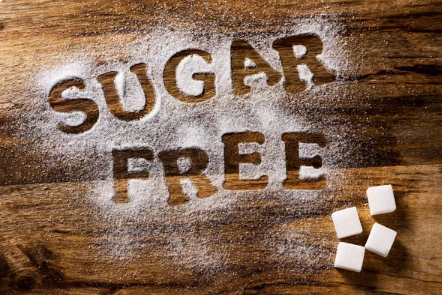
Sugar free living starts with small, intentional choices that break the loop of cravings, emotional eating, and guilt. In a world where processed foods and sugary treats are available at every corner, choosing a sugar free lifestyle can feel like an uphill battle. But the truth is, going sugar free isn’t about extreme diets or depriving yourself—it’s about reclaiming control over your health, energy, and emotional well-being. According to Harvard Health, added sugars are directly linked to higher risks of heart disease, insulin resistance, and chronic inflammation.”
For many of us, the cycle begins innocently enough—a mid-afternoon chocolate bar to “keep going,” a sweet dessert to reward ourselves after a long day, or even a couple of sugary drinks when stress hits. These moments, though comforting in the short term, often lead to a cascade of sugar cravings, mood swings, fatigue, and emotional eating that becomes difficult to manage. Over time, we may find ourselves reaching for sugar not because we’re hungry, but because we’re anxious, overwhelmed, lonely, or just mentally drained.
You’re not alone if you’ve ever felt stuck in this loop. In fact, millions of people struggle daily with the hidden impact of sugar on their emotional and physical health. That’s why sugar free living is more than just a trend—it’s a powerful, sustainable approach to nourishment, self-care, and freedom.
This post isn’t about blame, guilt, or harsh restriction. It’s about uncovering the real reasons behind your sugar cravings and emotional eating patterns. We’ll explore how sugar affects your brain chemistry, why stress and fatigue make you crave it even more, and how embracing a sugar free lifestyle can help you feel more balanced, satisfied, and in control.
By the end of this guide, you’ll understand the science behind your cravings and learn simple, practical ways to break free—without punishing yourself, counting every calorie, or giving up joy. Because going sugar free isn’t about perfection. It’s about progress. And that journey can start right now—with clarity, self-compassion, and the tools you need to thrive.
Understanding Sugar Cravings: It’s Not Just Willpower
Sugar cravings are often misunderstood as a lack of self-control. In truth, they’re more about your blood sugar levels, emotional triggers, and even hormonal imbalances.
When you eat foods high in refined sugar or simple carbs, your blood sugar spikes rapidly. This leads to a surge in insulin, followed by a crash. That crash signals your body to crave more sugar for a quick energy boost. This becomes a loop—insulin spikes, blood sugar drops, cravings return.
Add stress, poor sleep, or emotional tension to the mix, and the body starts associating sugary foods with comfort and reward. That’s the root of emotional eating—when food is used to soothe rather than to nourish.
Table of Contents
ToggleWhy We Crave Sugar & How a Sugar Free Lifestyle Can Help
Emotional eating is more than just eating when you’re sad. It can be triggered by anxiety, boredom, anger, loneliness, or even fatigue. When your cortisol (the stress hormone) levels rise, your body searches for ways to feel safe. For many of us, sugar is that quick fix.
Over time, the brain develops a reward response to sugary foods, reinforcing the habit neurologically. This is why sugar addiction is a real and deeply ingrained cycle—not just a bad habit.
The result? You feel out of control, experience mood swings, fatigue, and a constant craving for something sweet—even when you’re not hungry.
The Science Behind Sugar Cravings and Sugar Free Eating
Cravings are not the same as hunger. Hunger is a physical need. Cravings are an emotional or chemical response to triggers, including:
Skipping meals or eating too few calories
Highly processed foods with hidden sugars
Sleep deprivation
Stress and anxiety
Emotional memories tied to food
Unbalanced meals lacking protein, fiber, or healthy fats
Identifying your food triggers is the first step to gaining awareness and breaking the cycle. One effective method is food journaling—tracking what you eat, when, and how you feel before and after. Check out our guide to gut-friendly foods that naturally reduce sugar cravings and support your sugar free journey
How to Break Free Without Restriction
If you’ve ever tried a strict sugar detox or no-carb diet, you know that white-knuckling your way through cravings often backfires. The goal isn’t to eliminate all sugar forever. The goal is to build a more mindful, balanced relationship with food.
Here’s how to do that:
1. Balance Your Blood Sugar with Every Meal
A combination of protein, fiber, and healthy fats at each meal keeps your energy steady and reduces the likelihood of craving sugary snacks later. Try building meals with real, whole foods like vegetables, lean meats, legumes, seeds, and slow-digesting carbs.
2. Stay Hydrated
Dehydration is a hidden driver of cravings. Sometimes, thirst is misinterpreted as hunger—especially for sweet foods. Drinking water throughout the day can help you naturally reduce sugar cravings.
3. Get Enough Sleep
Lack of sleep disrupts ghrelin and leptin—your hunger and fullness hormones. When you’re tired, your body craves fast fuel, which often translates to refined sugar. Sleep optimization is a surprisingly powerful craving-management tool.
4. Practice Mindful Eating
Slow down. Taste your food. Chew thoroughly. Mindful eating means being present with your meal, which can help you identify when you’re actually full, satisfied, or just reacting emotionally. This practice strengthens self-control and reduces emotional snacking.
5. Find Healthy Swaps
Instead of eliminating sweets completely, try healthy alternatives that satisfy your sweet tooth while nourishing your body. Examples include:
Dates with almond butter
Dark chocolate (70%+ cacao)
Greek yogurt with berries
Banana with cinnamon
Chia pudding sweetened with fruit
These choices offer nutrition, fiber, and natural sugars that digest more slowly.
6. Address Emotional Eating at the Root
Instead of punishing yourself for emotional eating, ask: What am I really feeling? What do I actually need right now?
Sometimes it’s rest. Sometimes it’s connection. Sometimes it’s movement or fresh air. Learning to meet emotional needs without turning to food is powerful—and it’s a process worth practicing.
Sugar detoxes have become a popular first step for people looking to transition into a sugar free lifestyle—and for good reason. A well-structured sugar detox can help reset your taste buds, reduce sugar dependency, and bring your body back into balance after months or even years of processed, high-sugar foods.
But here’s the truth: a sugar detox is not a magic solution or a quick fix. If you’re doing a sugar detox just to drop weight quickly or punish yourself for eating poorly, it won’t lead to lasting change. In fact, many people fall into the trap of completing a short-term detox, only to return to old habits once it ends—often with stronger cravings than before.
Instead, the goal of a sugar detox should be to support a long-term shift into sugar free living, where you consciously reduce or eliminate added sugars from your daily life in a balanced, sustainable way. When done right, a sugar detox acts like a reset button for your brain and body. It helps:
Decrease inflammation
Rebalance blood sugar levels
Improve mental clarity
Reduce emotional eating triggers
Break the addictive cycle of processed sugar

What Happens During a Sugar Detox?
During the first 3–5 days of a sugar detox, it’s common to experience withdrawal symptoms like headaches, fatigue, irritability, and strong cravings. This is a sign that your body is adjusting to functioning without the constant sugar spikes and crashes.
By the end of the first week, however, many people report feeling lighter, clearer, and more in control. Taste buds begin to adjust, and natural sweetness in fruits, nuts, and whole foods becomes more satisfying. This is the foundation of a sugar free lifestyle—learning to appreciate food in its natural state, without artificial highs and crashes.
How to Do a Sugar Detox the Right Way
If you’re considering a sugar detox, here are some safe, sustainable steps to follow:
Focus on Whole Foods
Fill your plate with vegetables, lean proteins, healthy fats, nuts, seeds, and low-glycemic fruits like berries. Avoid anything that contains added sugars—even “healthy” ones like agave or maple syrup during detox.Stay Hydrated
Drink plenty of water and herbal teas. Dehydration can amplify sugar cravings. A good hydration routine supports detoxification and keeps your energy steady.Read Labels Carefully
Sugar hides under dozens of names: cane juice, dextrose, corn syrup, maltodextrin, and more. During a sugar detox, aim for zero added sugars—not just obvious sweets.Prepare for Emotional Triggers
Emotional eating often surfaces during a detox. Have sugar free coping strategies ready: take a walk, journal, meditate, or call a friend when cravings hit.Don’t Aim for Perfection—Aim for Progress
If you slip, don’t give up. One cookie doesn’t ruin your progress. Get back to your sugar free meals and move forward with self-compassion.
Sugar Detox vs. Sugar Free Lifestyle: What’s the Difference?
A sugar detox is temporary—a starting point to eliminate sugar and reset your system. A sugar free lifestyle, however, is about long-term balance and awareness. It doesn’t mean you can never have sugar again, but rather that you choose sugar more consciously, understand your triggers, and avoid falling back into emotional eating patterns.
Think of the detox as cleaning out your kitchen—and your bloodstream. The sugar free lifestyle is about keeping it clean.
Final Thoughts: Make Sugar Detox Work for Your Sugar Free Lifestyle
Doing a sugar detox can be an empowering step toward reclaiming your energy, emotional balance, and overall health. But the key is to integrate what you learn during the detox into a sugar free way of living that feels nourishing, not punishing.
Start small. A 7-day sugar detox is often enough to feel real change. Pair that with sustainable sugar free habits—like balanced meals, mindful eating, and emotional awareness—and you’ll build a lifestyle that supports both your physical and mental well-being.
Remember, the goal isn’t perfection—it’s freedom from cravings, clarity of mind, and a healthy relationship with food that lasts beyond any detox plan.

One thought on “The Truth About Sugar, Cravings & Emotional Eating (And How to Break Free)”